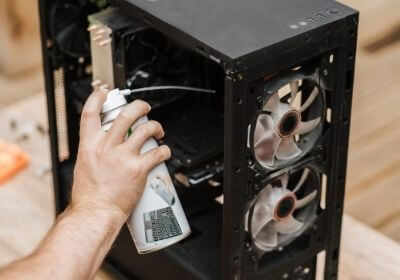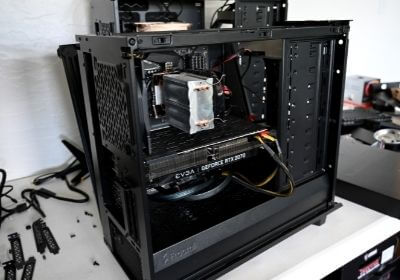
Cleaning your PC — tips on how to properly clean a PC
If you work at a computer a lot and it runs at maximum capacity, you’ll sometimes also hear an unmistakable noise that sounds like a drive getting louder. While the cooler works hard to ensure that nothing overheats, it isn’t necessarily as friendly as it seems. It’s both a friend and a foe: It does indeed help keep things cool, but due to the air it moves, it also stirs up and attracts a lot of dust that likes to settle inside. It’s therefore necessary to give the PC a clean every now and then.
Contents
The computer usually runs flawlessly for the first few months after it’s purchased. Depending on the usage, it takes some time until the cooler has absorbed enough dust so that the user notices something’s different. The first and most obvious sign is that the computer gets loud. You boot it up and after a few minutes it gets louder when it’s working. The dirtier it is inside, the louder it gets. At a certain point, the accumulated dust also causes the cooler’s performance to drop off. Now’s the time to act: If overheating occurs — and it might — the PC can be severely damaged inside and end up breaking down.

When dust accumulates inside the computer, it often isolates the various hardware elements from each other. If the degree of contamination is high, the computer can no longer perform as usual. And if the cooler then also isn’t up to par, the computer can become very hot. The sensitive parts inside the computer definitely require cooling — otherwise they’ll break and you won’t be able to use your computer anymore. To prevent such damage, you have to clean the device regularly.
When you decide to clean your PC, you don’t want to damage anything. There are some useful tips to consider when cleaning your PC.
- The PC should always be disconnected from the power supply first. Removing the dirt from the outside is often sufficient, but sometimes it’s so stuck that further measures have to be taken.
- A compressed air spray can be used from the outside. Inexpensive and available at PC stores or online, it’s handy for quickly removing dust and dirt from the sensitive power supply unit and the cooler.
- When the level of contamination is high and inaccessible, the PC needs to be opened.
- The cooler can usually be vacuumed out with ease. However, the cooler blades should always be blocked with an object when doing so. This is because they may otherwise start to rotate due to the air of the vacuum cleaner, which would then lead to a surge of the motherboard.
- If you want to clean the motherboard or other boards, you can use a brush. Don’t use the vacuum cleaner for this task — it can damage the sensitive equipment.
Sometimes you simply have to clean your PC. With the following instructions, you can do a thorough job of it.
Step 1: Remove coarse dirt
The best tool for this task is a vacuum cleaner. It is advisable to remove the case before checking if all the parts are sitting securely. The screws of the case should be put in a safe place so that they don’t get lost.
To prevent the fans from spinning, you can tie them together with a cable tie. This helps prevent bearing damage. Now you can start carefully vacuuming it up on the lowest level.
Step 2: Remove fine dirt
Circuit boards are very sensitive and should be cleaned with a brush. This is also a good method for removing dust from hard-to-reach places. Compressed air sprays with a tube attachment are also helpful and can remove any lost hairs or bristles from the brush.
Step 3: Remove stubborn dirt
If the vacuum cleaner and other tools are no longer effective, case fans and other components can be removed. Now a brush or toothbrush can be used to remove the more stubborn dirt. The case fan’s blades can quickly be cleaned with water. Chemical cleaning agents should be avoided.
Step 4: Clean the processor cooler
The processor should be cleaned as thoroughly as possible because it’s also important for computing performance. However, if the processor cooler is particularly dirty, removing it is worthwhile. This way, all areas can be reached and the thermal paste can also be reapplied. A vacuum cleaner, toothbrush, and brush can also help with less stubborn dirt.
Step 5: Reapply thermal paste
If the processor cooler has been removed, it’s possible to reapply the thermal paste. This isn’t always necessary, but is recommended if some of it has become detached while removing the cooler. First, all residues should be removed. A soft cloth or white spirit is suitable for this purpose. New thermal paste should only be applied sparingly and carefully.
Step 6: Clean the graphics card
To start, the card must be removed. This way, you can also clean the slot in the motherboard as well. You should only disconnect the heatsink from the graphics card if it is absolutely necessary. Cleaning the in-between spaces is usually sufficient.
Step 7: Avoid cable clutter
When cables are hanging around, it makes cleaning more difficult. Moreover, they really attract dust, which can lead to it finding its way in the case, where it ends up settling. You should therefore ensure that the cables don’t block the fans’ air flow. They should also lie in groups through the case — cable ties are handy for this. Make sure that there are no loose ends in the case.
Step 8: Mount dust filter
Available in specialist stores or online, dust filters come in different shapes and sizes. They are quick and easy to install and prevent dust from settling on the fan’s blades.
Step 9: Clean input devices
The surface of the keyboard and the mouse can be wiped with a damp cloth. Dirt in the spaces between the keys can be carefully tapped out if you turn the keyboard over. You can also get it out using a pair of tweezers or a can of compressed air. Furthermore, you can unscrew the case and clean the rubber mat inside with a damp cloth followed by a dry cloth.
How often you clean your computer depends on how often you use it. If you sit at the computer all day, regular cleaning is recommended. If you rarely use your computer, you don’t have to clean it very often. It also depends on whether you have a very strong fan or a weaker one. Strong fans attract more dirt and dust, meaning the computer needs to be cleaned more often.


Whether cleaning the PC causes the warranty to expire always depends on what measures you take in the cleaning process. If you clean the PC from the outside, the warranty doesn’t expire. However, if you open the PC, it might. More detailed information must be specifically requested from the manufacturer.
If you don’t dare to look inside the PC and clean it, you can have a professional take care of it. This is particularly advisable if you don’t have much experience. Professional cleaning can be done by the manufacturer or by certified PC repair shops. Depending on the amount of work involved, the price is between 60 and 90 euros. If you send the computer in to be cleaned, you will also have to pay for shipping.

For a computer to work well, you also have to take care of its insides. Cleaning it is part of this; those who don’t feel confident doing it alone can let a professional work on it. Cleaning your computer ensures that it will last longer, and doing so regularly will improve its performance.
